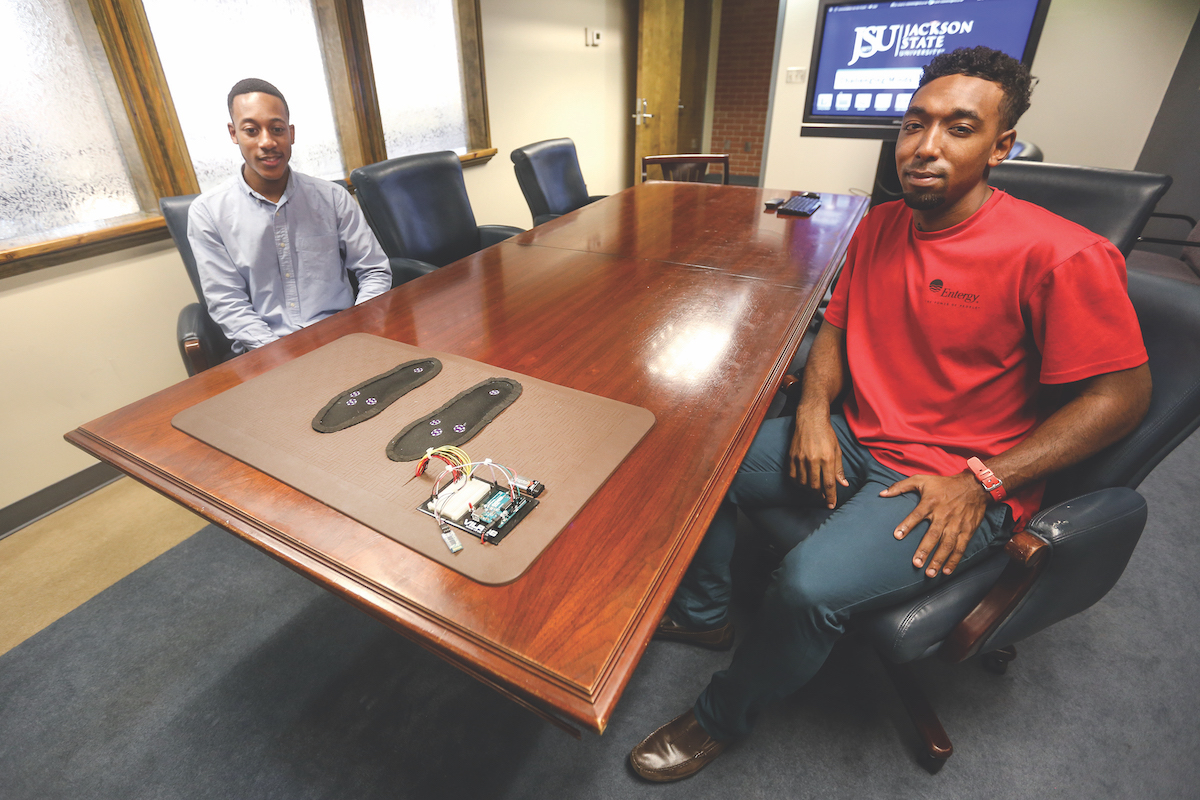Engineering students at Jackson State University have designed a “smart mat” that gauges the foot temperature of diabetics to help thwart the danger of lower extremity amputations – particularly in Mississippi, where the risk is greater, according to the CDC. Mississippi has one of the nation’s highest rates diabetes-related deaths in the nation, according to the Mississippi Department of Health and the Centers for Disease Control and Prevention. As part of their senior design project, JSU students in the College of Science, Engineering and Technology recently created the temperature-measuring device. For one group member, the “smart mat” project is personal.
Jann Butler, a senior computer engineering student, said ulcers led to his aunt’s amputation.
“As a result, we wanted to help other diabetic patients,” he said. “Upon research, we realized that a lot of them suffer foot ulcers, and we uncovered an issue with temperature. So, we developed a mat that diabetic patients could stand on to register the temperature of their feet. If there’s a four-degree difference between the two over a period of time, the lower one would be at greater risk of ulceration,” he said.
Butler, a native of Pascagoula, Miss., explained that a diabetic patient has abnormal (high) glucose levels in the blood, affecting its flow to the lower extremities. “This causes the foot to be colder than average,” he said. “By outputting temperature values, the patient can see which foot is more affected. Then, that information can be relayed to a physician.”
Dr. Gordon Skelton, professor in the Department of Electrical and Computer Engineering and director of the graduate program for

CDS&E (Computational Data-Enabled Sciences and Engineering), said this senior project, and others, sought solutions to real problems.
“A lot of the issues related to diabetes end up being problems with neuropathy and a few other things, resulting in the loss of feeling in your feet,” Skelton said. “You don’t really know there’s an issue until you develop an ulceration, which could possibly lead to worsening conditions that result in amputation. The condition could even accelerate a second amputation that can significantly compromise a person’s ability to move around.”
Skelton said the idea behind the smart mat was to realistically see if there was some means of collecting data for a doctor or caregiver as an early warning. “Products such as these have real value,” he added. Each senior project takes two semesters to complete. Senior Design I is the theoretical phase; Senior Design II is the implementation phase. Developers of the smart mat say they encountered a few problems along the way. Although the smart mat is quite durable and can be placed on most surfaces, team member Chevan Baker said one issue was that the original temperature sensor pads produced erroneous values due to moisture, such as wet feet. He said the group eventually switched to a sturdier, efficient, waterproof sensor called the lily pad.
Another issue occurred with formatting an accompanying Android app to display the data that was being collected. Baker, a computer engineering major from Kansas City, Mo., said the team eventually resolved that dilemma, too. The app, which is still being fully developed for access on other mobile devices, stores previous temperatures (Fahrenheit and Celsius) for future comparison. Butler, Baker and team members are engaged in ongoing discussions about modifications and placing the product on the market. Their other partners are Jordan Barber, a computer engineering native from Jackson, Miss., and Fred Harris, an electrical engineering native from Forest, Miss. The group says the mat cost slightly less than $500 to produce.
Among other products in this year’s slate of senior projects: Wireless pedometer: This device can be outfitted on running or dress shoes, for example. It measures the number of actual “foot strikes” and produces more accurate counts within a 90th percentile for users rather than current products on the market that calculate motion of any kind.
Smart bag: This product involves placing a device on backpacks or other bags and is especially useful to students who leave behind or misplace items such as laptops or iPads. With RFID (radio frequency identification) circuitry and pressure sensors, users know if an item is missing from a bag based on weight. The device also has Bluetooth technology to alert users leaving a room that an item is missing.
Automated RFID attendance: This device saves time and eliminates the need for professors, for example, to take roll. With a unique RFID tag, the electronic classroom attendance reader can determine each student’s name, when the person entered the room, whether the student left class early or whether the person was legitimately enrolled for a particular course. Also, it alerts the professor about the frequency of attendance. Of this year’s teams, Skelton said, “This was an excellent group of students who showed great promise for their engineering careers. They will make themselves and Jackson State University proud.”













Leave a Reply